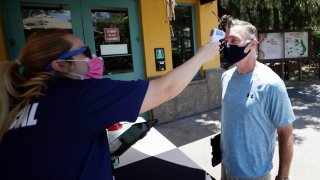
Utah and Oregon put any further reopening of their economies on hold amid a spike in coronavirus cases, but there was no turning back Friday in such states as Texas, California, Arkansas and Arizona despite flashing warning signs there, too.
One by one, states are weighing the health risks from the virus against the economic damage from the stay-at-home orders that have thrown millions out of work over the past three months.
And many governors are coming down on the side of jobs, even though an Associated Press analysis this week found that cases are rising in nearly half the states — a trend experts attributed in part to the gradual reopening of businesses over the past few weeks.
Should Your State Reopen?
For states considering lifting quarantine measures, the official guidelines propose either a downward trajectory of COVID-19 cases within two weeks or a downward trajectory of positive tests as a percent of total tests.
As shown below, when you compare yesterday’s new case count with that of two weeks ago, the number is often lower, simply because the counts fluctuate. Critics call the measures vague and ultimately because they aren’t binding, some states are choosing to reopen whether they meet the criteria or not.
Source: The COVID Tracking Project
Credit: Amy O’Kruk/NBC
Texas, which saw new highs this week for hospitalizations and new COVID-19 cases, prompting Houston's top county official, Lina Hidalgo, to warn that "we may be approaching the precipice of a disaster,” allowed restaurants to expand eat-in dining Friday to 75% of capacity, up from 50%.
“Oh, yeah, I’ve been concerned,” 32-year-old Renata Liggins said as she settled in front of a plate of brisket at Black’s Barbecue in Austin and the number of people now hospitalized with COVID-19 in Texas climbed to its highest level yet, at over 2,100. But "it just feels I can finally breathe a little bit.”
Alabama, which began reopening in early May, has seen more than a quarter of the state’s 23,000 cases come in the past two weeks as Republican Gov. Kay Ivey emphasized personal responsibility. And Arkansas, where both active cases and hospitalizations have more than doubled since Memorial Day, is letting restaurants seat more customers on Monday.
“Regardless of what we see in the next week, we made the right decision to go ahead and lift some of these restrictions so we don’t cause more damage to people’s lives and their livelihood,” GOP Gov. Asa Hutchison said.
How Coronavirus Has Grown in Each State — in 1 Chart
New York has quickly become the epicenter of the American coronavirus outbreak. This chart shows the cumulative number of cases per state by number of days since the 10th case.
Source: Johns Hopkins University
Credit: Amy O’Kruk/NBC
Arizona has become one of the most troubling hot spots in the U.S. as new cases have surged to more than 1,000 a day, up from fewer than 400 before stay-at-home orders expired in mid-May.
Republican Gov. Doug Ducey has given assurances the health care system can handle it, and Arizona Health Director Dr. Cara Christ said: "We are not going to be able to stop the spread, and so we can’t stop living as well.”
Even California, the site nearly three months ago of the nation’s first statewide stay-at-home order, entered the most expansive phase of its gradual reopening Friday, though its daily average of new cases is up by more than 600 from a week ago.
Wineries in California started uncorking their bottles and welcoming people back to their tasting rooms, and hotels, zoos, museums and aquariums were also allowed to reopen. San Francisco restaurants resumed outdoor dining, and the San Diego Zoo opened on a limited basis.
The Ebb and Flow of New Coronavirus Cases and Deaths
The graphs below illustrate the distribution of new coronavirus cases and deaths in the U.S. While New York accounted for the lion’s share of new cases and deaths in March and April, its numbers have declined in May as some states have increased. Hover or tap to see new daily cases and deaths across the country. States with the most are ordered top to bottom.
Source: The COVID Tracking Project
Credit: Amy O’Kruk/NBC
So far, only a small number of governors have shown a willingness to retreat, or at least hit pause.
Republican Gov. Gary Herbert of Utah and Democratic Gov. Kate Brown of Oregon said they would halt lifting further restrictions for the time being as new cases flare.
“As I've said before, reopening comes with real risk,” Brown said in announcing a one-week pause that will affect, among other places, Portland, the state's biggest city.
She said the increase in positive test results was caused in part by the reopening of some counties. Oregon reported 178 new cases Thursday, the highest count since the outbreak began.
Elsewhere around the country, Iowa bars, restaurants, theaters and other businesses were allowed to pack in more customers. Swimming pools, senior centers and adult day care centers were also cleared to open back up. Iowa is still seeing hot spots, especially near meatpacking plants.
While President Donald Trump has pushed hard for states to reopen, the decisions to charge ahead or go slow have not fallen neatly along partisan lines. California Gov. Gavin Newsom is a Democrat in the biggest blue state of them all.
In Texas, Republican Gov. Greg Abbott "is making pretty clear at this point he wants the economy to open," a worried Austin Mayor Steve Adler said. "My hope is that when he sees what kind of surge there's going to be, he does act at a state level."
DeMillo reported from Little Rock, Ark. Associated Press writers Andrew Selsky in Salem, Ore.; Kimberly Chandler in Montgomery, Ala.; and Bob Christie in Phoenix contributed to this report.

